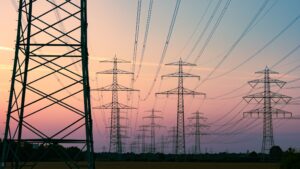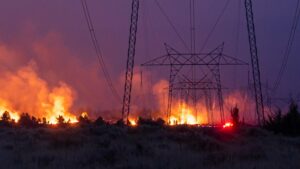On the road to net zero: Next steps for the utility sector
While the main outcomes from COP27 were focused on themes of loss and damage, adaptation and World Bank reform, conversations around the 1.5 degrees Celsius target, boosting low-emissions energy and the commitment to phase out the use of coal were still ever-present.
Some stakeholders were disappointed that these themes didn’t progress a great deal from COP26, but that doesn’t mean industry can’t step up and be the ones to lead the change.
Utilities need to transform. The energy sector underpins the entire economy and leaders will be evaluated by their actions and inactions for years to come.
Emissions deadlines are fast approaching
Now is the time for utilities to double down on their net-zero commitments. To make sure they’re taking concrete steps towards achieving their goals and building resiliency to achieve sustainable and inclusive growth.
While action continues to be slower than needed, more and more countries now see reducing emissions as being a national priority, with governments stepping up and making commitments.
- The UK government was the first major economy in the world to pass laws to end its contribution to global warming by 2050.
- The Canadian government has committed that the country’s electricity grid will produce net-zero greenhouse gas emissions by 2035.
- The US government recently pledged $370 billion toward advancing renewal energy and reducing greenhouse gas emissions—its largest investment in combatting climate change to date.
Collaboration is needed throughout the energy value chain, it’s nothing short of all hands on deck. So, we’re sharing ideas from across the industry for you to consider when building or revisiting your strategic plans and optimizing your capital investment plans over the coming years.
1. Transform your emission reduction targets into metrics, and metrics into forecasts
There is no one way to achieve net-zero. Each utility will need to set their own course, and their own milestones. But it’s imperative that there is a target to start, and a way to keep track of progress. Net-zero pledges must be turned into reality. While many businesses across industries have made good-faith pledges, most implementation plans are still light on the details.
One power utility in North America has done just this. Their clean energy commitments come with a clear plan of how and when they will achieve it.
Before 2030, they will:
- Modernize their energy grid. With over two thirds of their planned capital being allocated to wires.
- Increase renewable generating portfolio to approximately half of total capacity. The renewables they’re focusing on are wind and solar, and expect to power almost 3 million homes.
Commitments need to be turned into action, and there needs to be greater transparency around progress to date. One way of doing that is to use tools that allow you to analyze different what-if scenarios to assess the best ways of reaching your targets.
2. Evaluate investments based on long-term benefits and risks
Investments in reactive, one-off projects should be reduced, with more budgeted for large-scale, enduring resiliency projects that bring long-term value.
Utilities have always been trying to align their short-term metrics with their long-term goals, but now more than ever investments need to be made that are linked with risk mitigation, total cost of ownership metrics, and supply chain management.
One of America’s largest utilities has a clearly defined clean energy transition plan. Not only have they set themselves clear targets (net-zero methane emissions from its natural gas business and at least a 50% carbon reduction from electric generation by 2030) but they’ve set out an investment plan that supports it. They’ll be doing this by investing in grid enhancements and energy storage, and exploring zero-emission power generation technologies such as nuclear and hydrogen.
3. The future is (mostly) electric
In an effort to boost low-emission energies to meet the future needs of the growing global population, discussions around gas and nuclear are back on the table. While every possibility must be assessed, gas may have lower emissions than coal, but it is still a major fossil fuel, and nuclear generating stations take notoriously long to build. To realistically meet targets, infrastructure projects need to be up and running yesterday.
The next few years will be critical, and electricity that comes from renewable resources, rather than sources that emit pollutants, is still the best solution to reduce greenhouse gas emissions.
That doesn’t make it the easy option though. Canada already has one of the cleanest electricity grids, with over 80% of the electricity it produces coming from non-greenhouse-gas-emitting sources. But for them to reach net zero, they will need to produce up to two to three times as much electricity as they do now.
While we continue this journey of electrification, utilities must still find ways to balance progress alongside affordability and reliability for the consumer.
4. Build grids that can absorb impacts and bounce back
Severe weather events are becoming more predictable. In 2020 there were 22 weather and climate disasters in the US alone. Given the increasing number of climate-related weather events, and the devastating impacts they can have, resiliency planning needs to be baked into the current integrated investment planning process.
Some effects of climate change are less sporadic than others, though. Greenhouse gas emissions must fall by about 45% by 2030 compared with 2010 levels and reach net zero by 2050. Except for a short time during the pandemic lockdowns, carbon emissions have been steadily rising since 2015, when the Paris agreement was signed. We aren’t going to be able to keep the global temperature rise below 1.5 degrees Celsius.
As temperatures continue to rise, do you know what impact that will have on your infrastructure? What will you be doing to mitigate that? You need to have robust strategies in place that balance risk and trade-offs, so you aren’t left with no options in front of you.
5. Work with your customers and local communities
Recent research suggests that even though the public thinks that business can have a big impact on climate, 64% of people in 14 countries think that business is ‘mediocre or worse’ at keeping their climate promises.
Many utilities understand their responsibility, and have set up formal programs around environmental stewardship, governance, social impact and sustainable growth. So, they can create value with and for all their stakeholders; employees, customers, investors and local communities.
What’s the cost of inaction?
Reaching net zero isn’t the end goal. Tick the box, we’re done, back to normal. Building a sustainable future is a multi-generational challenge.
As you can see from some of the work highlighted here, there is greater alignment between industry and society than ever before. The priority is elevated, there is a lot of engagement and advocacy work taking place, and new technologies are being integrated all the time to help utilities reach their goals.
The conversation needs to be reframed; what are we working towards versus what are we trying to avoid? After all, the green transformation offers vast opportunities for investments in infrastructure and energy.
There also needs to be a change in mindset. Historically the industry has been very risk averse, and this has been a barrier to any real change. Everyone agrees that new energy infrastructure is desperately needed, but decision making around these investments is a long, drawn-out process, and time isn’t on our side.
Faster processes need to be put in place, and an understanding that some investments might not bring in the same level of ROI, but that the work being done has a net positive effect and that risks will be mitigated along the way.
People know what needs to be done, just not how to do it. Your next step should be to empower your teams to be able to make the right decisions today, so that they can work on getting things done.
Learn more about the benefits of AIP.



